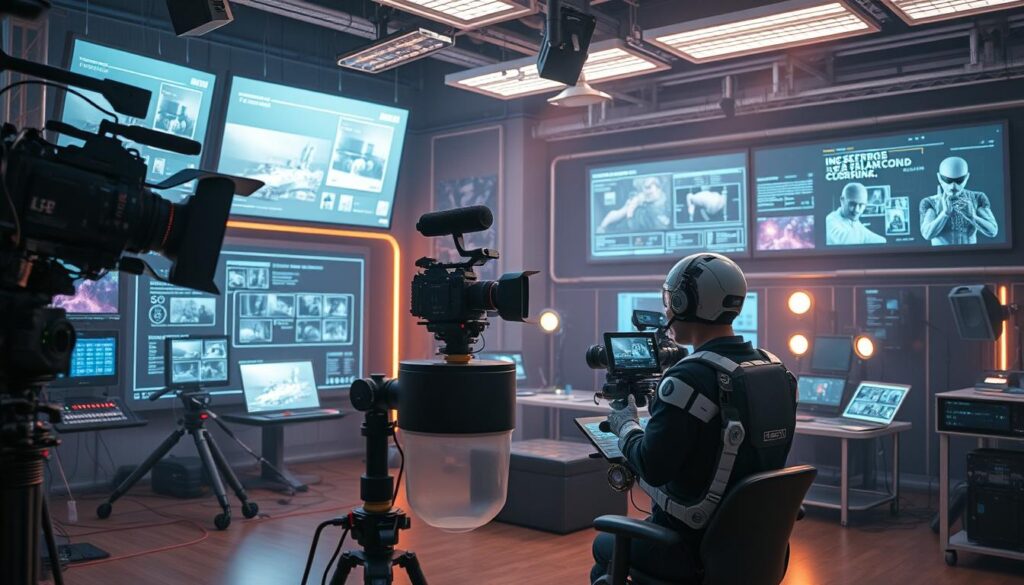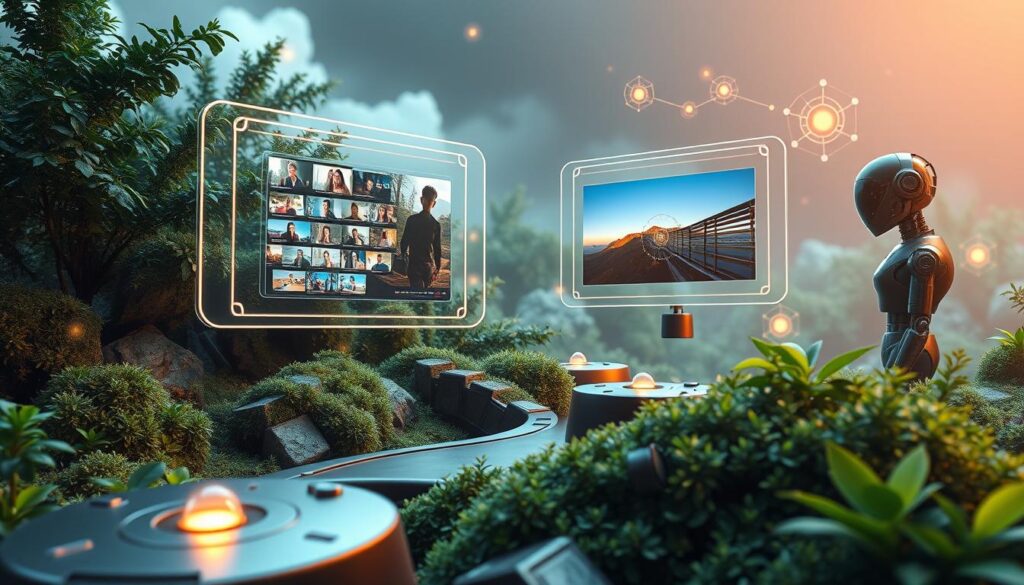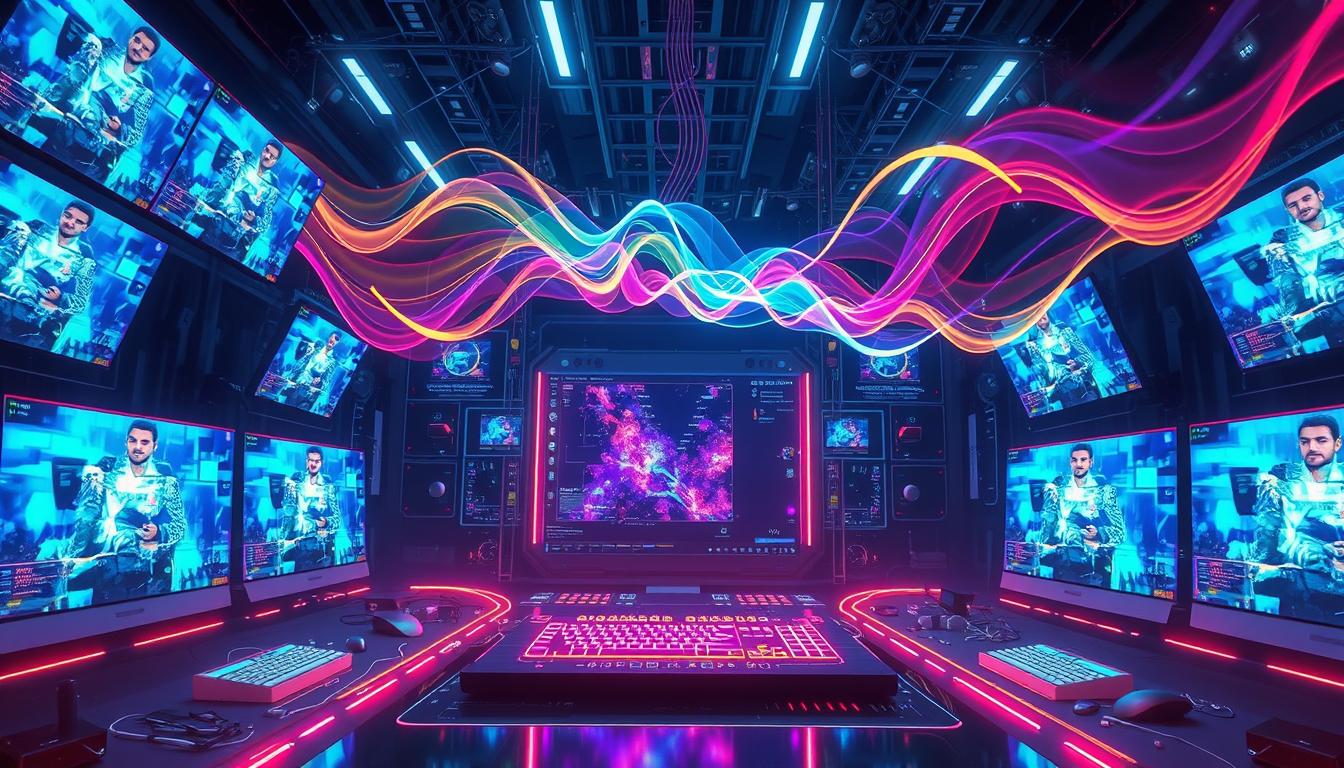The media production world is about to change drastically. Thanks to OpenAI’s Sora, we’re entering a new era of AI video generation. This cutting-edge AI technology makes high-definition videos from text descriptions. It’s not just about better videos but changing how creators work. Sora marks a step into uncharted territories, showing how advanced intelligence can change video creation.
Sora is catching the eye of tech experts and revolutionizing higher education marketing. It makes learning content more exciting and easy to access. OpenAI ensures Sora handles complex tasks like object occlusion with care, stressing on ethical AI video creation. Though still in early testing, Sora hints at big changes in media and raises important discussions on ethics and safety.
Key Takeaways
- Sora is setting a new precedent in the quality and ease of AI video generation, promising to revolutionize educational content production.
- Content creators are finding in Sora an innovative ally to produce compelling content effortlessly, enhancing the learning experience.
- Through its sophisticated tools, Sora enables personalized video content creation, fostering enhanced engagement with students.
- OpenAI’s commitment to ethical AI use is evident in Sora’s safety measures and transparent content generation process.
- While the public release of Sora is on hold, the ongoing development and safety testing point to a profound impact on video production and the creative arts.
Exploring the Capabilities of OpenAI’s Sora
OpenAI’s latest creation, Sora, is changing AI video generation. It outshines its predecessors with its ability to keep videos coherent. Sora uses top-notch neural network technology and deep learning methods. It turns complex text prompts into videos that look great and make sense over time.
How Sora Surpasses Other AI Video Tools
Sora is a standout in AI tech, solving problems that other AI video tools couldn’t. It’s great at making videos from just a little bit of text. This is something other tools like Runway Gen 2 and Pika struggle with, as they often make videos that don’t fully make sense. Sora gets how users think, thanks to its machine learning and detailed natural language processing. It creates videos that are lively and full of details.
Understanding Realistic Video Generation from Text Prompts
Sora’s good at making videos because of its advanced technique. It starts with noise and then makes clear scenes using a smart design. This way, the AI keeps track of the topic throughout the video. It’s better than other AIs at understanding time in videos and the small details. This marks a big step forward in NLP applications. Sora can mimic the real world and complex actions more accurately than before.
Anticipating the Impact of AI on Video Content Creation
Sora is setting the stage for the future of making videos. It brings new tools for those who tell stories and make content. This is big news for marketing, movies, and online content. It starts a new age of creativity powered by AI. These tools make it easier and open new ways to tell stories, changing the game for professionals in many fields.
The ongoing inclusion of Sora in various fields is important. It’s changing how we tell stories and make content with AI technology. Every improvement makes it easier to make great video content with AI. This is a big step in using machine learning and AI for creative work.
Innovations Behind OpenAI’s Sora
OpenAI’s Sora leads the way in AI-driven creativity with its advanced AI models. These models break new ground in video generation. The key to this advancement lies in pioneering technologies. They provide better understanding of context and improve media production.
- Sora can create videos up to a minute long from text prompts, showing its skill in understanding context.
- Its video quality is seen as better than those by Runway, thanks to OpenAI’s tech improvements in Sora.
- Through ‘iterative deployment’, Sora grows using feedback from visual artists and filmmakers, fine-tuning its features.
- Choosing transformers over U-Nets in diffusion models helps Sora process data more smartly. This makes video creation quicker and more precise.
Transformers boost Sora’s capability for complex AI tasks. They improve the system’s scalability and enhance performance. This is vital for crafting detailed, high-resolution videos that grasp the depth of content and context.
OpenAI focuses on safety in Sora’s development, working with red teamers to pinpoint risks and devise countermeasures. This reflects OpenAI’s aim to build increasingly safer AI systems. Sora also has classifiers, made with red teamers, to help users identify AI-generated content. This tackles ethical issues around AI-created false information.
Introducing diffusion transformers is not just an AI model breakthrough. It sets a new standard for AI-driven creativity in various media.
Sora’s innovations enable it to produce high-quality videos. These videos closely match those made by experts, opening new creative doors in digital media.
The Intersection of AI and Creativity in OpenAI’s Sora
The world of artificial intelligence (AI) is changing the creative scene. OpenAI’s Sora is leading this shift. It stands as a huge step forward in creative applications of AI. It also sets new standards in visual arts innovation.

Sora is famous for creating high-definition videos from text. It’s making big waves in AI in filmmaking. This tech not only brings stories to life in new ways. It also gives visual artists and filmmakers the freedom to showcase their ideas. They can do this without the limits of normal video making.
Enabling New Avenues for Visual Artists and Filmmakers
Developed by OpenAI, now valued at over $150 billion, Sora mixes technology with creativity. It uses an advanced process to turn rough ideas into clear, engaging visual stories. This opens new doors for visual arts innovation.
Unleashing Creative Potential Beyond Human Limits
Sora offers tools that push human creativity further. Artists can make 1080p resolution videos up to one minute long from just a text prompt. This shows Sora’s potential to revolutionize digital storytelling and entertainment.
Following a big data leak, OpenAI has focused more on ethical AI development and safety. These steps make sure Sora not only boosts creativity. They also mean it’s used in a safe and responsible way, keeping all users secure.
- Enhanced text-to-video alignment
- High-resolution video generation capabilities
- New frontiers in creative expression
The blend of AI and creativity with OpenAI’s Sora is leading us into an exciting future. It’s pushing what’s possible in technology and what can be imagined in art.
Safety, Ethics, and Future Implications of AI Video Generation
AI-generated content is rapidly advancing with tools like OpenAI’s Sora leading the way. This highlights the need for responsible AI development to ensure safety in AI technology. With Sora’s advanced capabilities, it’s essential to consider the ethical use of such technology.

OpenAI is taking steps towards ethical AI use by working with other experts and creating safety measures. They use outside assessments and experts to check and improve their systems to prevent misuse. The conversations about the ethical use of AI-generated content, for education or entertainment, are becoming more important.
“As AI technology continues to evolve, so too must our approaches to safeguarding its use, ensuring AI develops along a trajectory that benefits society as a whole.”
- Safety Measures: Leveraging advanced text and image classifiers to proactively detect and prevent harmful content.
- Collaboration with Experts: Engaging Red Teamers to test for misinformation, bias, and hateful content in AI applications.
- Transparency: Integration of C2PA metadata to enhance the reliability and transparency of AI-generated media.
Tools are being developed to identify content made by Sora. This helps manage risks linked to deepfakes and digital manipulation. By fostering open dialogue and continuous learning, OpenAI aims to mitigate risks and increase AI-generated content‘s positive effects. Working with global stakeholders, including policymakers and educators, is crucial in supporting both innovation and responsible AI development.
In conclusion, Sora is a big step forward in AI for video generation. However, it also highlights the importance of balancing innovation with responsibility. For AI to truly benefit us, it must be developed and used with careful attention to safety and ethics.
Conclusion
In the world of AI and videos, the Sora tool by OpenAI stands out. It shows us what the future of video making could look like. Major film studios such as Paramount and Warner Brothers have seen its potential. Sora turns short text into detailed videos in less than a minute, showing off its high quality and consistency.
The release of Sora made big waves in the entertainment world. Even Tyler Perry is thinking twice about spending big on traditional setups now. But, bringing in Sora and similar tech has its downsides too. A lot of film companies are cutting jobs—75% have reduced their staff because AI can do the work. By 2026, over 100,000 jobs in entertainment might be lost, leading unions to rethink their contracts.
Sora is a leap forward, making clear, high-resolution videos. It keeps the story straight from one scene to the next. But, it’s caught in a tricky spot with legal and ethical issues. Questions about where its training data comes from are big. The New York Times has even sued over it. OpenAI is trying to be careful, by limiting who can use Sora and by keeping an eye out for misuse.

